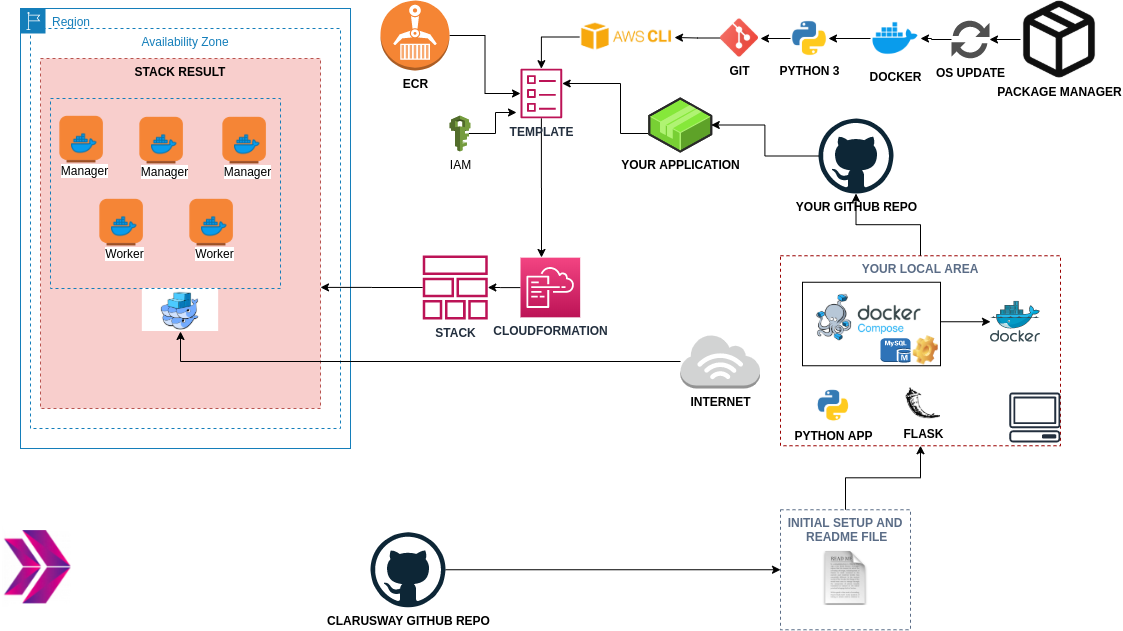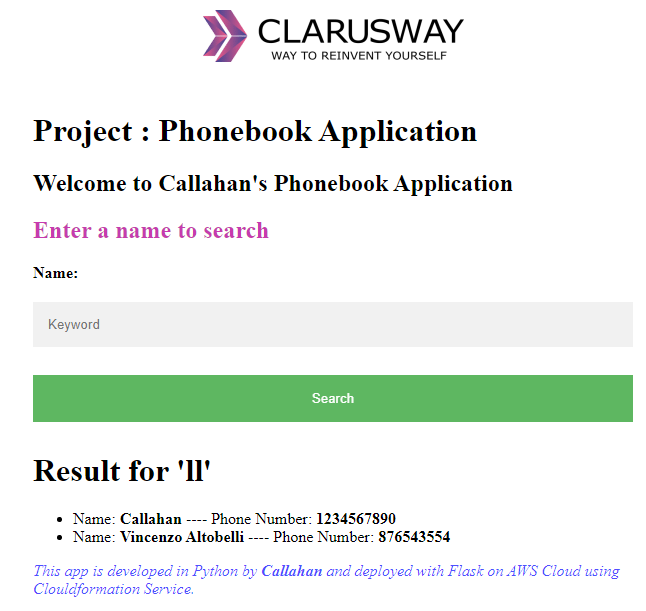Project-202: Docker Swarm Deployment of Phonebook Application (Python Flask) with MySQL
Description
This project aims to deploy the Phonebook Application web application with Docker Swarm on Elastic Compute Cloud (EC2) Instances by pulling the app images from the AWS Elastic Container Registry (ECR) repository.
Problem Statement
-
Your company has recently started a project that aims to serve as phonebook web application. Your teammates have started to work on the project and developed the UI and backend part of the project and they need your help to deploy the app in development environment.
-
You are, as a cloud engineer, requested to deploy the Phonebook Application in the development environment on Docker Swarm on AWS EC2 Instances using AWS Cloudformation Service to showcase the project. To do that you need to;
-
Create a new public repository for the project on GitHub.
-
Create docker image using the
Dockerfilefrom the base image ofpython:alpine. -
Deploy the app on swarm using
docker compose. To do so on theComposefile;-
Create a MySQL database service with one replica using the image of
mysql:5.7;-
attach a named volume to persist the data of database server.
-
attach
init.sqlfile to initialize the database usingconfigs.
-
-
Configure the app service to;
-
pull the image of the app from the AWS ECR repository.
-
deploy the one app for each swarm nodes using
globalmode. -
run the app on
port 80.
-
-
Use a custom network for the services.
-
-
Push the necessary files for your project to the new project repo.
-
-
You are also requested; to use AWS ECR as image repository, to create Docker Swarm with 3 manager and 2 worker node instances, to automate the process of Docker Swarm initialization through Cloudformation in the development environment. To achieve this goals, you can configure Cloudformation template using the followings;
-
The application stack should be created with new AWS resources.
-
The application should run on Amazon Linux 2 EC2 Instance
-
EC2 Instance type can be configured as
t2.micro. -
To use the AWS ECR as image repository;
-
Enable the swarm node instances with IAM Role allowing them to work with ECR repos using the instance profile.
-
Install AWS CLI
Version 2on swarm node instances to useaws ecrcommands. -
Use Amazon ECR Credential Helper to allow Docker to interact with ECR easily.
-
-
To automate the process of Docker Swarm initialization;
-
Install the docker and docker-compose on all nodes (instances) using the
user-databash script. -
Create a separate instance with
instance profileto be first manager node of the swarm. Within theuser-datascript;-
Set the first manager node hostname as
Grand-Master. -
Initialize Docker swarm.
-
Create a docker service named
vizon the manager node on port8080using thedockersamples/visualizerimage, to monitor the swarm nodes easily. -
Create an image repository on ECR for the app
-
Build the docker image from the GitHub URL of the new project repo and tag it appropriately to push it on ECR repo. (Note: Do not forget to install Git to enable Docker to work with git commands)
-
Download
docker-compose.ymlfile from the repo and deploy application stack on Docker Swarm.
-
-
Create a launch template with
instance profilefor Manager Nodes. Within theuser-datascript;-
Install the python
ec2instanceconnectclipackage formsshcommand. -
Connect from manager node to the
Grand-Masterto get thejoin-tokenand join the swarm as manager node usingmsshcommand.
-
-
Create two manager node instances using the
Manager Launch Template. -
Create a launch template with
instance profilefor Worker Nodes. Within theuser-datascript;-
Install the python
ec2instanceconnectclipackage to usemsshcommand. -
Connect from worker node to the
Grand-Masterto get thejoin-tokenand join the swarm as worker node usingmsshcommand.
-
-
Create two worker node instance using the
Worker Launch Template.
-
-
Create a single security group for all swarm nodes and open necessary ports for the app and swarm services.
-
Tag the swarm node instances appropriately as
Docker Manager/Worker <Number> of <StackName>to discern them from AWS Management Console. -
The Web Application should be accessible via web browser from anywhere.
-
Phonebook App Website URL, Visualization App Website URL should be given as output by Cloudformation Service, after the stack created.
-
Project Skeleton
202-docker-swarm-deployment-of-phonebook-app-on-python-flask-mysql (folder)
|
|----readme.md # Given to the students (Definition of the project)
|----cfn-template.yml # To be delivered by students (Cloudformation template)
|----phonebook-app.py # Given to the students (Python Flask Web Application)
|----requirements.txt # Given to the students (List of Flask Modules/Packages)
|----init.sql # Given to the students (SQL statements to initialize db)
|----Dockerfile # To be delivered by students
|----docker-compose.yml # To be delivered by students
|----templates
|----index.html # Given to the students (HTML template)
|----add-update.html # Given to the students (HTML template)
|----delete.html # Given to the students (HTML template)
Expected Outcome
At the end of the project, following topics are to be covered;
-
Docker Swarm Deployment
-
Web App and MySQL Database Configuration in Docker Swarm
-
Bash scripting
-
AWS ECR as Image Repository
-
AWS IAM Policy and Role Configuration
-
AWS EC2 Launch Template Configuration
-
AWS EC2 Configuration
-
AWS EC2 Security Group Configuration
-
AWS Cloudformation Service
-
AWS Cloudformation Template Design
-
Git & Github for Version Control System
At the end of the project, students will be able to;
-
demonstrate how to configure Dockerfile and docker-compose files.
-
set up a Docker Swarm cluster to work with AWS ECR using Cloudformation.
-
deploy an application stack on Docker Swarm.
-
create and configure AWS ECR from the AWS CLI.
-
use Docker commands effectively to tag, push, and pull images to/from ECR.
-
demonstrate bash scripting skills using
user datasection in Cloudformation to install and setup Docker and application environment on EC2 Instances. -
demonstrate their configuration skills of AWS EC2, Launch Templates, IAM Policy, Role, Instance Profile, and Security Group.
-
configure Cloudformation template to use AWS Resources.
-
show how to use AWS Cloudformation Service to launch stacks.
-
apply git commands (push, pull, commit, add etc.) and Github as Version Control System.

